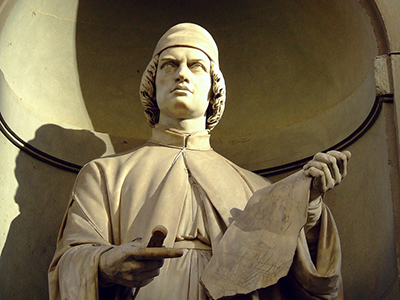
L.B. Alberti and Michelangelo’s Last Judgment (a detail)
We are living a second Renaissance
When I was doing my walk the other day, I thought of great artists, both alive and dead, who in spite of their talent and success, managed to remain humble. While we can find this type of people not only in the arts, but also in business, politics and media, it is not the norm. Moreover, achieving a balance between success and humility (in the sense of unpretentiousness) is not easy in such a competitive and spectacle-driven society as ours. As you know, since Walk the Arts manages an art association, teaches in post-secondary establishments and offers painting workshops in Europe, we are constantly meeting artists of all levels and characters. While we have met many of the talented-humble type, we have also met some of ordinary knowledge, but egos the size of an elephant, egos that wouldn’t fit through the front door of our houses.
Certainly, artists as Picasso and Dali had that type of ego and we all know that and in fact, it was part of their DNA fabric. But when you think about Cézanne, Pollock, Mondrian and even Duchamp, they were humble. When Degas and Seurat painted, they professed an act of humility. Of course they voiced their opinion in an extroverted way, in a fervent way. Of course, as a professor, you can passionately transmit proven sound art knowledge. However, between knowledge and ego, there is a world apart.
All this led to the Renaissance class I was giving the other day and forced me to reread part of Le Vite (The Lives) by Vasari. Did Michelangelo or Masaccio had a big ego? What about the great L.B. Alberti who proclaimed in his book on painting (Della Pittura) that the artist should be, foremost, a good person? And all the other art theoreticians of the time, such as Varchi, Pino, Ludovico also mentioned the goodness and the knowledge that all artist should convey and share.
It is true that these Italian names refer to the Renaissance. But since the advent of the Internet in 1994, we have been living a second Renaissance. Internet is an incredible source of knowledge. Witnessing the amazing talent and innovation of artists from all over the world and the quality of top museums and art galleries can only help us realize the smallness of our worlds compared to the World. So, how can an artist of a small pond be pretentious in a world so full of talent and challenges?
When you paint, you reveal yourself. Is your work of art a subconscious way of telling, “Hey look what I can do. Can you do that?” Hmmm! If yes, I think your ego recall’s Picasso. But if your painting bears this reflection: “This is what I did to the best of my knowledge and intention. Is it relevant? Is it meaningful?”, then I think you are truly manifesting an act of humility. Too many times, I see ordinary works painted with ordinary techniques from artists who think they were born on “Jupiter’s thigh” as we say in French.
We shall never forget that in today’s Renaissance we live in the “share” era. The true artist remains humble. Your work of art is something you share and not show as an ostentatious act. Never forget that glory is ephemeral unless, of course, you belong to the artist’s pantheon.


Cela m’a fait du bien de connecter avec cette valeur partagée quant à l’humilité nécessaire dans l’expression de son art ou de ses connaissances dans la rencontre avec l’autre, elle semble moins fréquente parmi les gens que j’entends ou côtoie…
J’ai parcouru votre site en détails et avec plaisir… cela m’a impressionné tant dans le contenu que dans la forme…je projette de faire un premier “walkthearts” à New York en mars 2016.
J’aime peindre et me développer tant dans l’apprentissage que par les voyages. Je n’ai pas de formation formelle en art. Offrez vous des ateliers aussi dans la région, je serais libre le jour ou en soirée…
Au plaisir de participer s’il y a encore de la place.
Merci, thank you Cécile.